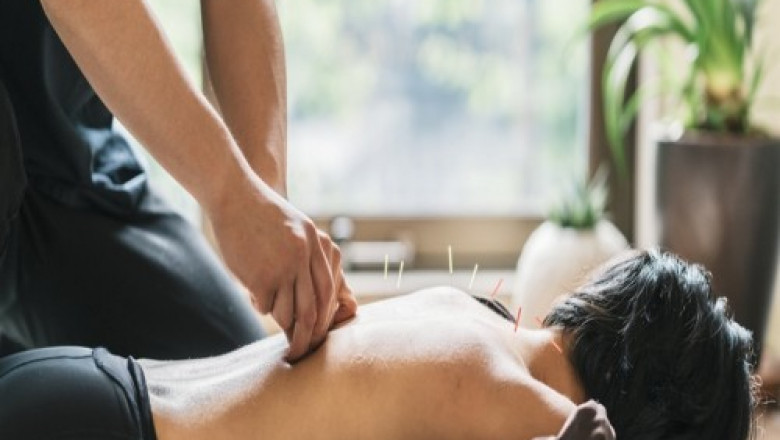views
What is Acupuncture?
Acupuncture is a component of traditional Chinese medicine involving thin needles inserted into the skin at specific points on the body. For over 2,000 years, it has been widely used in China and other Asian countries, and is becoming increasingly popular in Western nations. During an acupuncture treatment, the acupuncturist will insert ultra-fine, sterile needles through the patient's skin at specific anatomical points on the body. Acupuncture points are believed to associate with the pathways or meridians through which energy or "qi" flows, and manipulating acupuncture needles is believed to remove energy blockages and restore balanced energy flow, promoting health and well-being.
How Does Acupuncture Work?
According to traditional Chinese medicine theory, the human body contains a network of energy pathways called "meridians". Along these meridians are more than 360 specific anatomical points, known as acupuncture points. These points exist along the meridian pathways and are believed to connect to organs, tissues and functions in the body. Inserting needles stimulates the acupuncture points to restore the healthy flow of qi along these meridians. If qi flow is disrupted or blocked, imbalances may occur which are believed to be responsible for illness or disease. Through the stimulation of acupuncture points, practitioners believe the normal physiological functions regulated by qi can be positively influenced.
Potential Benefits of Acupuncture
Acupuncture has been shown to effectively treat many health conditions including pain, nausea, stress and anxiety. Clinical research has demonstrated it can help relieve:
- Back, neck and joint pain: Studies show acupuncture can help reduce chronic back and neck pain, arthritis pain, and other musculoskeletal issues.
- Headaches and migraines: Multiple research studies and reviews have found acupuncture to be effective at preventing and treating frequent headaches and migraines when used alone or in combination with standard treatment.
- Nausea and vomiting: Research reviews have determined acupuncture is an effective anti-emetic, meaning it is useful in preventing or treating nausea and vomiting including that associated with chemotherapy, surgery and pregnancy.
- Anxiety, stress and depression: Clinical trials suggest acupuncture may help ease symptoms of anxiety, depression and stress, alone or in combination with standard care.
Safety Considerations with Acupuncture
Generally, acupuncture is considered quite safe when performed by a qualified practitioner using sterile needles. However, certain risks and precautions apply:
- Bleeding or bruising: Since very thin needles are inserted in the skin, occasional minor bleeding or bruising may occur at insertion sites. This typically stops on its own and is of no medical concern.
- Fainting: In rare cases, people may feel lightheaded or dizzy during or shortly after treatment, sometimes resulting in fainting. Patients are advised to lie down following treatment until feeling fully alert again.
- Infection: Using only sterile, single-use needles minimizes the very small risk of contracting an infection like hepatitis B or HIV/AIDS. Practitioners in Western nations are additionally required to follow infection control regulations.
- Medical contraindications: Acupuncture is not appropriate during pregnancy in certain areas of the body or for people with bleeding disorders or implanted devices like pacemakers. Practitioners should be made aware of patients' complete medical history.
Herbal Supplements in Chinese Medicine
Herbal supplements are an important part of traditional Chinese medicine therapy and are often used alongside acupuncture. Hundreds of herbs exist which are categorized by their energetic properties and believed to influence qi, blood, fluids and organ functions when consumed as extracts, tinctures or teas. Common Chinese herbal formulas contain carefully balanced combinations of 3 to 12 individual herbs, each uniquely contributing to the formula's intended purpose. Some popular herbal formulas and their functions include:
- Yin Qiao San - Used to treat common colds, sore throats, coughs and flu-like symptoms. Contains honeysuckle, forsythia, peppermint and licorice.
- Dang Gui Buxue Tang - A tonic herbal tea meant to nourish blood and strengthen the body's qi flow. Includes angelica, astragalus, rehmannia and white atractylodes.
- Si Wu Tang - Helps alleviate symptoms related to premenstrual syndrome (PMS) and is believed to warm the uterus and relieve cramping. Combines angelica, chuanxiong, peach seed and licorice.
A Holistic Treatment Approach
Using acupuncture, Chinese herbal medicine and lifestyle adjustments all work synergistically according to traditional Chinese medical theory. Making dietary, exercise and stress management changes can further optimize treatment outcomes. Examples include:
- Eating lighter, warming foods during cold or flu season to support spleen qi function.
- Consuming more iron-rich foods like spinach and liver when experiencing blood deficiency symptoms like anemia.
- Avoiding late nights, excess caffeine or alcohol to maintain balanced liver qi levels.
- Practicing gentle stretching or tai chi to circulate qi and relax the body and mind.
By addressing root imbalances rather than just symptoms alone, acupuncture aims to restore homeostasis and support natural healing in a holistic way over both short and long term. Its non-invasive nature and generally low safety risk profile have contributed to acupuncture being widely embraced globally.
Get This Report in Japanese Language: 鍼治療
Get This Report in Korean Language: 침술
About Author:
Vaagisha brings over three years of expertise as a content editor in the market research domain. Originally a creative writer, she discovered her passion for editing, combining her flair for writing with a meticulous eye for detail. Her ability to craft and refine compelling content makes her an invaluable asset in delivering polished and engaging write-ups.
(LinkedIn: https://www.linkedin.com/in/vaagisha-singh-8080b91)






















Comments
0 comment